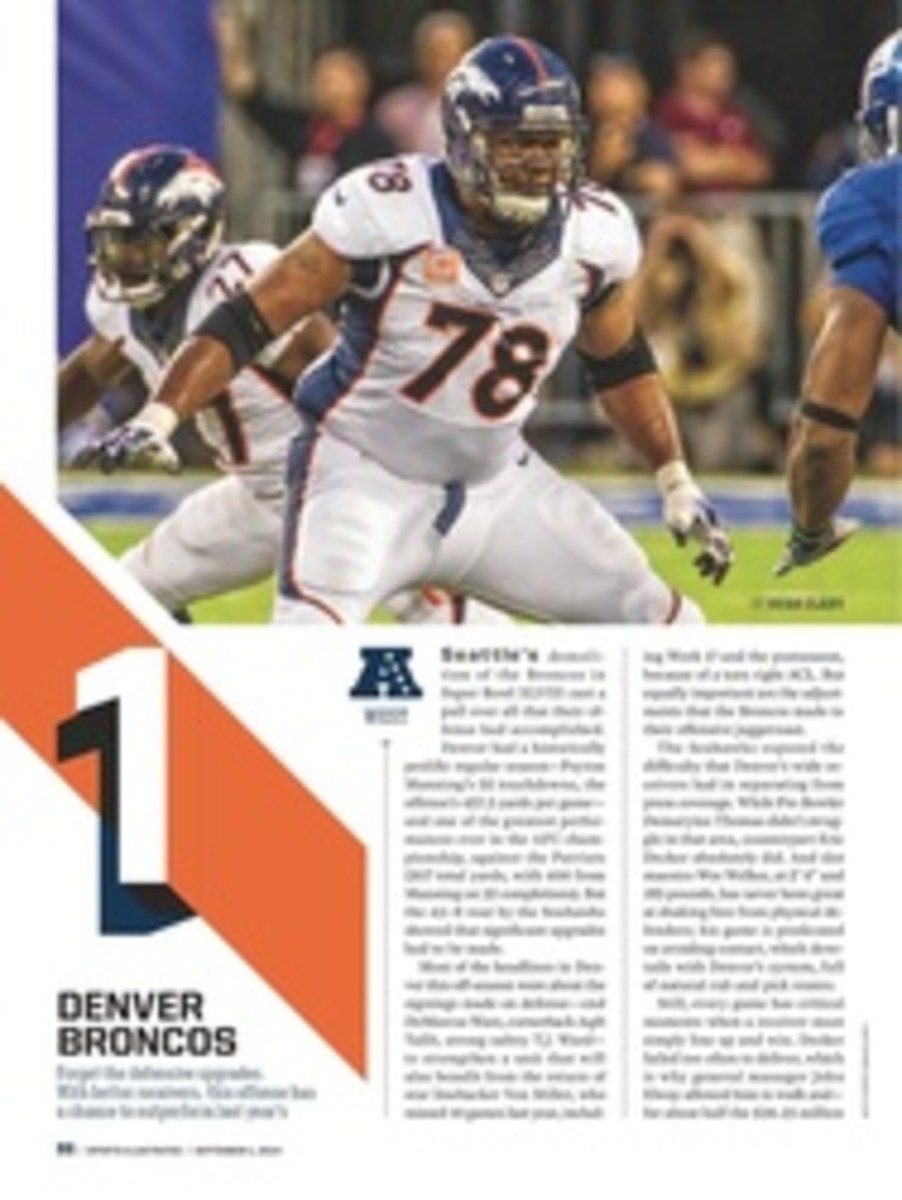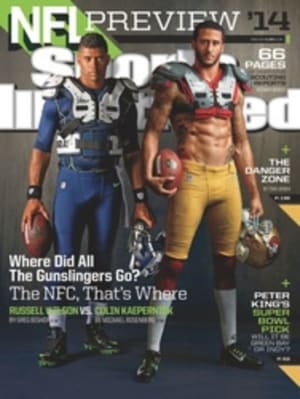
2 CHICAGO BEARS
Most of the time when a pundit talks about "good coaching," he's just dealing in empty Skip Bayless--style rhetoric—a judgment made after the fact. Maybe there will be some allusion to the coach's motivational skill, but who outside the locker room can accurately assess that? Besides, pep talks don't matter to players; what does is operating in a system that maximizes their talent.
Thanks to a deep understanding of his personnel, second-year coach Marc Trestman has built a system that's as effective as it is comprehensive. For years the Bears' roster has been vastly superior on defense. But that changed in 2013, after the defense suffered a slew of injuries and a talented offense finally developed its identity.
That identity begins, boringly enough, with the blocking up front. Even before signing tackle Jermon Bushrod (Saints) and guard Matt Slauson (Jets) in free agency in 2013, Trestman hired former New Orleans offensive line coach Aaron Kromer as his coordinator and tasked him with helping install pass protections. Now, instead of waiting and reacting to a defender's attack, every Chicago lineman is taught to be the aggressor. That's the opposite of how typical pass protection works, but it explains why Bushrod and Slauson each enjoyed career years, and why, on the right side, first-round guard Kyle Long and fifth-round tackle Jordan Mills survived as rookie starters.
These aggressive protections create a bigger pocket for quarterback Jay Cutler, an insanely gifted gunslinger who, under Trestman, has been diligently trying to sharpen his footwork, mechanics and progression timing. Many of these core elements are still new to the 31-year-old, and he has a ways to go in terms of consistency. But, as his new seven-year, $126.7 million contract ($54 million of it guaranteed) shows, the Bears believe he can get there.
Under Trestman, Cutler's infamously sour attitude has sweetened—perhaps because he's getting pummeled much less frequently. After being sacked 2.6 times per game in his first four years in Chicago, Cutler last season averaged just 1.7. And his unofficial QB hits were way down. Some of that can be credited to his improved timing and mechanics, but more of it has to do with Trestman's use of six- and seven-man protections. According to Football Outsiders, the Bears used six offensive linemen (typically adding guard Eben Britton) on a league-high 15.9% of their snaps in 2013. No other team was above 10%.
They can afford to sacrifice pass-catching personnel for extra blockers because, with the monstrous duo of Brandon Marshall (6'4", 230 pounds) and Alshon Jeffery (6'3", 216), they have wide receivers who consistently defeat double coverage downfield. Marshall, a strong route runner (especially against zone looks), has been the primary concern of most opposing defenses. But after the long-striding, huge-handed Jeffery showed off his playmaking prowess in his second season, that will change. All the better for Marshall.
Boasting a dominant receiving tandem is one thing; knowing how best to use it is another. Here, more points for Trestman, who likes to deploy both wideouts on the same side of the field, usually in "tight" formations—inside the numbers, sometimes nuzzled near the offensive line. This creates more field for the route runners and, because of the unbalance, shrinks the number of coverage disguises that Cutler will encounter.
After the snap Trestman uses an array of lethal route combinations in which his receivers intersect off the line of scrimmage—a switch release, in football parlance—and he enhances the attack by incorporating tight end Martellus Bennett, a 6'6" jump-ball specialist, as well as versatile running back Matt Forte.
Forte speaks to another example of good coaching. Over his first five years in the NFL he wasn't taught the ins and outs of pass protection. Trestman and Kromer taught him. Using his new understanding of blocking mechanics, Forte has turned one of the offense's glaring weaknesses into a strength. With his smooth hips and sharp vision, he is finally a complete back.
These are the nuts and bolts of well-designed, well-coached football—vastly more important than any locker room speech. Barring more injuries on defense, they're also what make the Bears a contender for the NFC North crown, if not a conference title.
2014 SCHEDULE
2013 Record: 8--8
WEEK 1
BUF [HOME]
SF [AWAY]
NYJ MON [AWAY]
GB [HOME]
CAR [AWAY]
ATL [AWAY]
MIA [HOME]
NE [AWAY]
BYE
GB [AWAY]
MIN [HOME]
TB [HOME]
DET THUR [AWAY]
DAL THUR [HOME]
NO MON [HOME]
DET [HOME]
MIN [AWAY]
WEEK 17
THE BIG FIX
The defensive front
The Bears allowed an NFL-worst 161.4 yards per game on the ground last season—and a shameful 197.1 after Week 6. Any improvement against the run begins with linebackers Lance Briggs and D.J. Williams, who combined to start just 13 games last year. Their return to health allows second-year 'backers Jon Bostic and Khaseem Greene to learn off the bench. The line has been upgraded, with a new defensive end trio of Lamarr Houston (from the Raiders), Jared Allen (Vikings) and Willie Young (Lions). Houston is a solid run-stopper; Allen lost a step last year but can be a force under a more controlled snap count; and Young has the speed to get 10 sacks. Inside, behind the talented but injury-prone Jeremiah Ratliff and Stephen Paea, Chicago has second-round rookie Ego Ferguson (LSU) and third-rounder Will Sutton (Arizona State). Both draftees are viewed as gap penetrators, not blocker-eaters, which suggests the Bears have every intention of sticking with their basic but well-taught 4--3 zone scheme. If Chicago's D can merely avoid injuries, better run-stopping is almost guaranteed.
THE CASE FOR
Cornerback Charles Tillman
Corners aren't supposed to maintain their Pro Bowl form into their mid-30s. But while some minor injuries in recent years have made Tillman, 33, appear old at times, there's nothing on film to suggest that he's not still a top-shelf player. He has intercepted three passes each of the past three seasons, returned five of them for touchdowns and forced a staggering 17 fumbles. (No other player has more than 14 in that span.) As one of the best off-man corners in football—that is, a zone or a man-to-man defender who does not press receivers off the line—Tillman has a masterly grasp of angles and route combinations. He also has a near-perfect understanding of how to use his help, be it a safety over the top, a linebacker underneath or (often overlooked) the sideline. As great as the veteran leader is, the Bears know his days are numbered: They re-signed him for just one season and drafted zone-based corner Kyle Fuller (Virginia Tech) in the first round. But with a revamped pass rush designed to force quarterbacks into quick throws, Tillman could have the type of year that will force Chicago to re-up him again.
PHOTO
JONATHAN DANIEL/GETTY IMAGES
QB JAY CUTLER
PHOTO
MIKE DINOVO/USA TODAY SPORTS
NINTEEN PHOTOS

